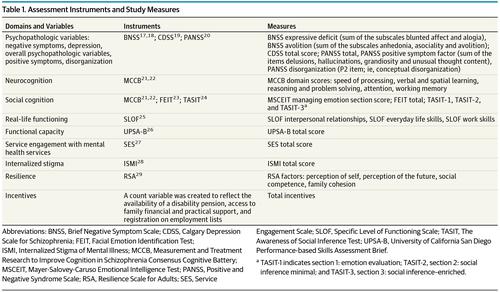JAMA Psychiatry ( IF 25.8 ) Pub Date : 2018-04-01 , DOI: 10.1001/jamapsychiatry.2017.4607 Silvana Galderisi 1 , Paola Rucci 2 , Brian Kirkpatrick 3 , Armida Mucci 1 , Dino Gibertoni 2 , Paola Rocca 4 , Alessandro Rossi 5 , Alessandro Bertolino 6 , Gregory P. Strauss 7 , Eugenio Aguglia 8 , Antonello Bellomo 9 , Martino Belvederi Murri 10 , Paola Bucci 1 , Bernardo Carpiniello 11 , Anna Comparelli 12 , Alessandro Cuomo 13 , Domenico De Berardis 14 , Liliana Dell’Osso 15 , Fabio Di Fabio 16 , Barbara Gelao 6 , Carlo Marchesi 17 , Palmiero Monteleone 18 , Cristiana Montemagni 4 , Giulia Orsenigo 19 , Francesca Pacitti 5 , Rita Roncone 20 , Paolo Santonastaso 21 , Alberto Siracusano 22 , Annarita Vignapiano 1 , Antonio Vita 23, 24 , Patrizia Zeppegno 25 , Mario Maj 1 ,

|
Importance Enhanced understanding of factors associated with symptomatic and functional recovery is instrumental to designing personalized treatment plans for people with schizophrenia. To date, this is the first study using network analysis to investigate the associations among cognitive, psychopathologic, and psychosocial variables in a large sample of community-dwelling individuals with schizophrenia.
Objective To assess the interplay among psychopathologic variables, cognitive dysfunctions, functional capacity, personal resources, perceived stigma, and real-life functioning in individuals with schizophrenia, using a data-driven approach.
Design, Setting, and Participants This multicenter, cross-sectional study involved 26 university psychiatric clinics and/or mental health departments. A total of 921 community-dwelling individuals with a DSM-IV diagnosis of schizophrenia who were stabilized on antipsychotic treatment were recruited from those consecutively presenting to the outpatient units of the sites between March 1, 2012, and September 30, 2013. Statistical analysis was conducted between July 1 and September 30, 2017.
Main Outcomes and Measures Measures covered psychopathologic variables, neurocognition, social cognition, functional capacity, real-life functioning, resilience, perceived stigma, incentives, and service engagement.
Results Of 740 patients (221 women and 519 men; mean [SD] age, 40.0 [10.9] years) with complete data on the 27 study measures, 163 (22.0%) were remitted (with a score of mild or better on 8 core symptoms). The network analysis showed that functional capacity and everyday life skills were the most central and highly interconnected nodes in the network. Psychopathologic variables split in 2 domains, with positive symptoms being one of the most peripheral and least connected nodes. Functional capacity bridged cognition with everyday life skills; the everyday life skills node was connected to disorganization and expressive deficits. Interpersonal relationships and work skills were connected to avolition; the interpersonal relationships node was also linked to social competence, and the work skills node was linked to social incentives and engagement with mental health services. A case-dropping bootstrap procedure showed centrality indices correlations of 0.75 or greater between the original and randomly defined samples up to 481 of 740 case-dropping (65.0%). No difference in the network structure was found between men and women.
Conclusions and Relevance The high centrality of functional capacity and everyday life skills in the network suggests that improving the ability to perform tasks relevant to everyday life is critical for any therapeutic intervention in schizophrenia. The pattern of network node connections supports the implementation of personalized interventions.
中文翻译:

Interplay的在精神病理的变量,个人资源,上下文相关的因素,和现实生活中的个体运作与精神分裂症网络分析
重要性 增强对与症状和功能恢复有关的因素的了解有助于设计精神分裂症患者的个性化治疗计划。迄今为止,这是第一项使用网络分析研究精神分裂症社区居民个体的认知,心理病理和社会心理变量之间关联的研究。
目的 通过数据驱动的方法评估精神分裂症患者的心理病理变量,认知功能障碍,功能能力,个人资源,感知的污名和现实生活功能之间的相互作用。
设计,设置和参与者 这项多中心的横断面研究涉及26个大学的精神病学诊所和/或精神卫生部门。从2012年3月1日至2013年9月30日间连续向现场门诊就诊的患者中,共招募了921名通过DSM-IV诊断为精神分裂症的稳定精神分裂症治疗社区居民。于2017年7月1日至9月30日进行。
主要结果和措施 措施涵盖心理病理学变量,神经认知,社会认知,功能能力,现实生活功能,适应力,可感知的污名,动机和服务参与度。
结果 在740例患者(221名女性和519名男性;平均[SD]年龄,40.0 [10.9]岁)中,有关于27种研究指标的完整数据,其中有163例(22.0%)缓解了(在8个核心症状上得分为轻度或更好) )。网络分析表明,功能能力和日常生活技能是网络中最中心和高度互连的节点。精神病理学变量分为2个域,阳性症状是最周围和连接最少的节点之一。功能能力将认知与日常生活技能联系在一起;日常生活技能节点与组织混乱和表达能力不足有关。人际关系和工作技能与意志力有关;人际关系节点也与社会能力有关,而工作技能节点则与社会激励和参与精神卫生服务联系在一起。案例删除自举程序显示原始样本和随机定义的样本之间的中心指数相关性为0.75或更高,高达740个案例删除中的481个(65.0%)。男女之间的网络结构没有差异。
结论和相关性 网络中功能能力和日常生活技能的高度集中性表明,提高执行与日常生活相关的任务的能力对于精神分裂症的任何治疗性干预都是至关重要的。网络节点连接的模式支持个性化干预措施的实施。



























 京公网安备 11010802027423号
京公网安备 11010802027423号